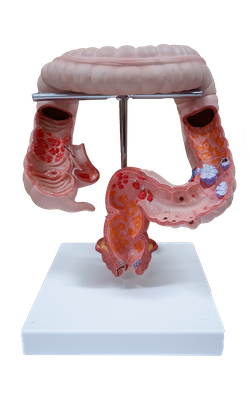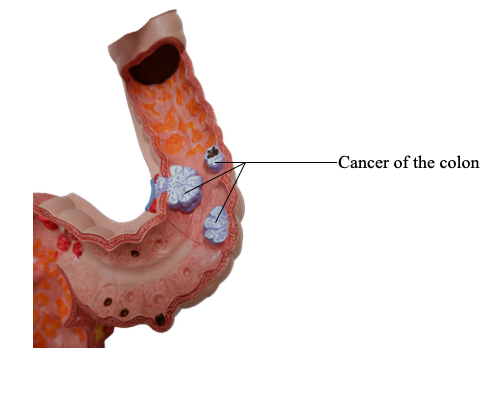Main Model

Cancer of the colon

Adenocarcinoma
Adenocarcinoma of the colon is the most common malignancy of the gastrointestinal tract and is a major contributor to morbidity and mortality worldwide. By
contrast, the small intestine, which accounts for 75% of the
overall length of the gastrointestinal tract, is an uncommon
site for benign and malignant tumors. Among malignant
small-intestinal tumors, adenocarcinomas and carcinoid
(neuroendocrine) tumors have roughly equal rates of occurrence, followed by lymphomas and sarcomas.
Epidemiology
Each year in the United States, there are more than 130,000
new cases and nearly 50,000 deaths from colorectal adenocarcinoma. This represents nearly 15% of all cancer-related deaths, second only to lung cancer. Colorectal
cancer incidence peaks at 60 to 70 years of age; less than
20% of cases occur before 50 years of age. Males are affected
slightly more often than females. Colorectal carcinoma is
most prevalent in the United States, Canada, Australia, New Zealand, Denmark, Sweden, and other (so-called)
developed countries that share lifestyles and diet. The incidence of this cancer is as much as 30-fold lower in India,
South America, and Africa. In Japan, where incidence was
previously very low, rates have now risen to intermediate
levels (similar to those in the United Kingdom), presumably as a result of changes in lifestyle and diet.
The dietary factors most closely associated with
increased colorectal cancer rates are low intake of unabsorbable vegetable fiber and high intake of refined carbohydrates and fat. In addition to dietary modification,
pharmacologic chemoprevention has become an area of
great interest. Several epidemiologic studies suggest that
aspirin or other NSAIDs have a protective effect. This is
consistent with studies showing that some NSAIDs cause
polyp regression in patients with FAP in whom the rectum
was left in place after colectomy. It is suspected that
this effect is mediated by inhibition of the enzyme
cyclooxygenase-2 (COX-2), which is highly expressed in
90% of colorectal carcinomas and 40% to 90% of adenomas
and is known to promote epithelial proliferation, particularly in response to injury.
Pathogenesis
Studies of colorectal carcinogenesis have provided fundamental insights into the general mechanisms of cancer
evolution. The combination of molecular events that lead to
colonic adenocarcinoma is heterogeneous and includes
genetic and epigenetic abnormalities. At least two distinct
genetic pathways, the APC/β-catenin pathway and the microsatellite instability pathway, have been described. In
simplest terms, mutations involving the APC/β-catenin pathway lead to increased WNT signaling, whereas those
involving the microsatellite instability pathway are associated with defects in DNA mismatch repair.
Both pathways involve the stepwise accumulation of multiple mutations, but the genes involved and the mechanisms
by which the mutations accumulate differ. Epigenetic events,
the most common of which is methylation-induced gene
silencing, may enhance progression along both pathways.
- The APC/β-catenin pathway. The classic adenomacarcinoma sequence, which accounts for as much as 80% of sporadic colon tumors, typically involves mutation of the APC tumor suppressor early in the neoplastic process. For adenomas to develop, both copies of the APC gene must be functionally inactivated, either by mutation or epigenetic events. APC is a key negative regulator of β-catenin, a component of the WNT signaling pathway. The APC protein normally binds to and promotes degradation of β-catenin. With loss of APC function, β-catenin accumulates and translocates to the nucleus, where it activates the transcription of genes, such as those encoding MYC and cyclin D1, that promote proliferation. This is followed by additional mutations, including activating mutations in KRAS, which also promote growth and prevent apoptosis. The conclusion that mutation of KRAS is a late event is supported by the observations that mutations are present in fewer than 10% of adenomas less than 1 cm in diameter, 50% of adenomas greater than 1 cm in diameter, and 50% of invasive adenocarcinomas. Neoplastic progression also is associated with mutations in other tumor suppressor genes such as SMAD2 and SMAD4, which encode effectors of TGF-β signaling. Because TGF-β signaling normally inhibits the cell cycle, loss of these genes may allow unrestrained cell growth. The tumor suppressor gene TP53 is mutated in 70% to 80% of colon cancers but is uncommonly affected in adenomas, suggesting that TP53 mutations also occur at late stages of tumor progression. Loss of function of TP53 and other tumor suppressor genes is often caused by chromosomal deletions, highlighting chromosomal instability as a hallmark of the APC/β-catenin pathway. Alternatively, tumor suppressor genes may be silenced by methylation of CpG islands, a 5' region of some genes that frequently includes the promoter and transcriptional start site. Expression of telomerase also increases as lesions become more advanced.
- The microsatellite instability pathway. In patients with DNA mismatch repair deficiency (due to loss of mismatch repair genes), mutations accumulate in microsatellite repeats, a condition referred to as microsatellite instability. These mutations generally are silent, because microsatellites typically are located in noncoding regions, but other microsatellite sequences are located in the coding or promoter regions of genes involved in regulation of cell growth, such as those encoding the type II TGF-β receptor and the proapoptotic protein BAX. Because TGF-β inhibits colonic epithelial cell proliferation, type II TGF-β receptor mutants can contribute to uncontrolled cell growth, while loss of BAX may enhance the survival of genetically abnormal clones.
- CpG island hypermethylation phenotype (CIMP). In a subset of colon cancers with microsatellite instability, there are no mutations in DNA mismatch repair enzymes. These tumors demonstrate the CpG island hypermethylation phenotype (CIMP). In these tumors, the MLH1 promoter region is typically hypermethylated, thereby reducing MLH1 expression and repair function. Activating mutations in the BRAF oncogene are common in these cancers. In contrast, KRAS and TP53 are not typically mutated. Thus, the combination of microsatellite instability, BRAF mutation, and methylation of specific targets, such as MLH1, is the signature of this pathway of carcinogenesis.
Morphology
Overall, adenocarcinomas are distributed approximately equally
over the entire length of the colon. Tumors in the proximal colon often grow as polypoid, exophytic masses that
extend along one wall of the large-caliber cecum and ascending colon; these tumors rarely cause obstruction.
By contrast, carcinomas in the distal colon tend to be
annular lesions that produce "napkin ring" constrictions
and luminal narrowing, sometimes to the point of
obstruction. Both forms grow into the bowel wall over time and
may be palpable as firm masses. The general microscopic characteristics of right- and left-sided colonic adenocarcinomas are similar. Most tumors are composed of tall columnar
cells that resemble dysplastic epithelium found in adenomas. The invasive component of these tumors elicits
a strong stromal desmoplastic response, which is responsible
for their characteristic firm consistency. Some poorly differentiated tumors form few glands. Others may produce
abundant mucin that accumulates within the intestinal wall, and
these carry a poor prognosis. Tumors also may be composed of signet ring cells similar to those in gastric cancer.
Clinical Features
The availability of endoscopic screening combined with
the recognition that most carcinomas arise within adenomas presents a unique opportunity for cancer prevention.
Unfortunately, colorectal cancers develop insidiously and
may therefore go undetected for long periods. Cecal and
other right-sided colon cancers most often are called to clinical attention by the appearance of fatigue and weakness due
to iron-deficiency anemia. Thus, it is a clinical maxim that
the underlying cause of iron-deficiency anemia in an
older male or postmenopausal female is gastrointestinal
cancer until proven otherwise. Left-sided colorectal adenocarcinomas may produce occult bleeding, changes in bowel
habits, or cramping left lower-quadrant discomfort.
Although poorly differentiated and mucinous histologic
patterns are associated with poor prognosis, the two most
important prognostic factors are depth of invasion and the presence or absence of lymph node metastases. These factors
were originally recognized by Dukes and Kirklin and form
the core of the TNM (tumor-node-metastasis) classification
and staging system from the American Joint Committee on
Cancer. Staging systems have become more complex with
time, reflecting more nuanced treatment approaches and
personalized therapeutic strategies. The most important
distinctions are:
- Depth of invasion. Tumors limited to the submucosa (i.e., those that do not cross the muscularis mucosae) have 5-year survival rates approaching 100%, while invasion into the submucosa or muscularis propria reduces 5-year survival to 95% and 70% to 90%, respectively (for tumors limited to the primary site). Invasion through the visceral serosal surface or into adjacent organs and tissues reduces survival further.
- The presence of lymph node metastases further compromises survival. As a result, most cases with lymph node metastases receive radiation or chemotherapy. In some cases, these treatments may be administered prior to primary tumor resection, a process termed neoadjuvant therapy. Molecular characterization of the tumor can be helpful in guiding the specific therapeutic approach.
- Distant metastases to lung, liver, or other sites also limits survival, and only 15% or fewer of patients with tumors at this stage are alive 5 years after diagnosis. Because of the portal drainage, the liver is the most common site of metastatic lesions. However, the rectum does not drain by way of the portal circulation, and metastases from carcinomas of the anorectum region often circumvent the liver.
Summary
• The vast majority of colonic cancers are adenocarcinomas.
They arise either by APC/β-catenin pathway or the microsatellite instability pathway. The two most important prognostic
factors are depth of invasion and the presence or absence of
metastases to lymph nodes or distant organs.